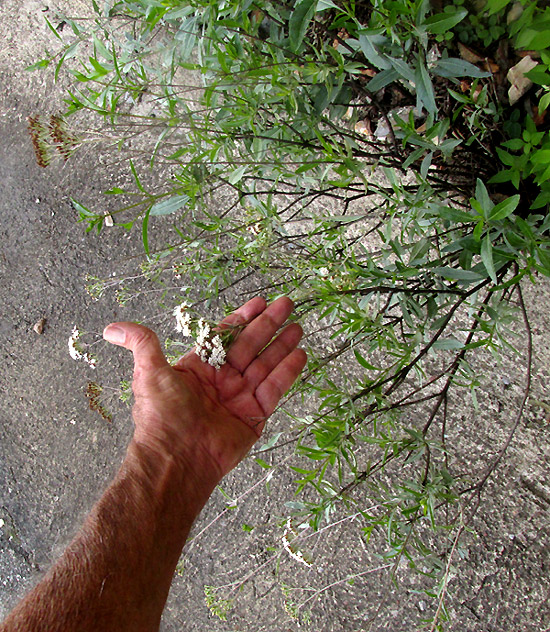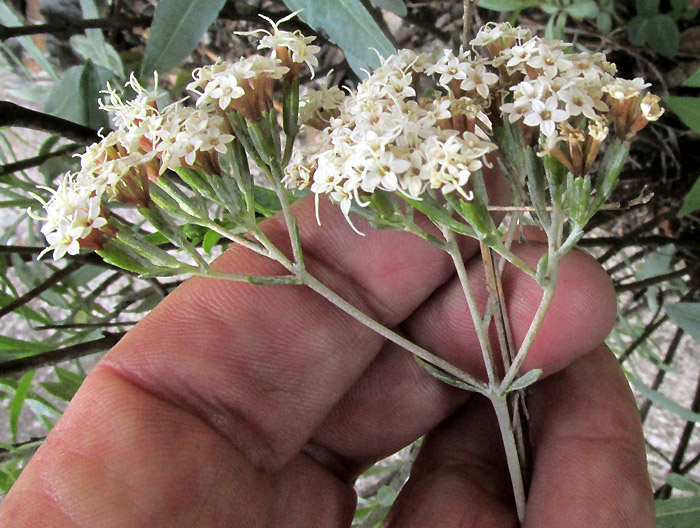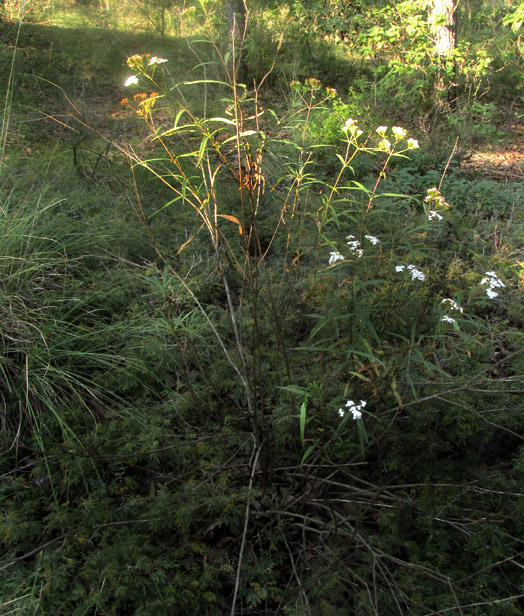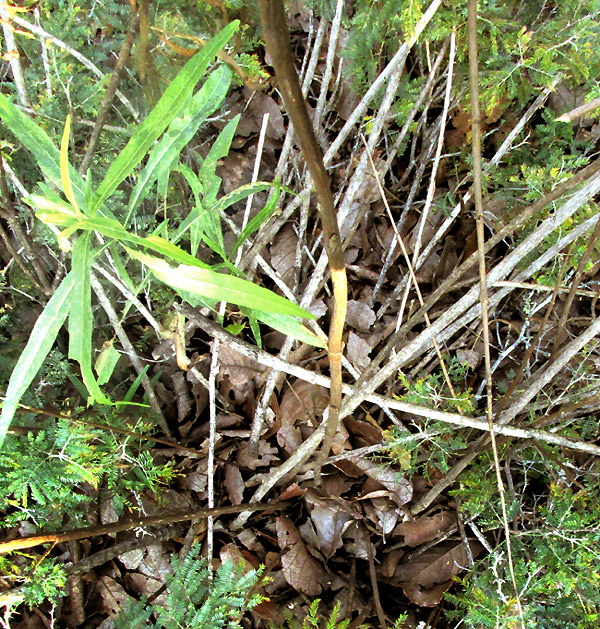Excerpts from Jim Conrad's
Naturalist Newsletter
Entry from field notes dated August 31, 2023, taken in Los Mármoles National Park in the Eastern Sierra Madre mountains, Hidalgo state, MÉXICO, along steeply climbing road heading eastward out of town of Trancas {on maps designated "Morelos (Trancas)"} toward Nicolás Flores; juniper/pine forest on limestone bedrock; elevation ~2,200m (~7,200ft); ~N20.80°, ~W99.25°
WILLOW-LEAF CANDYLEAF

The beginning of the little road climbing eastward of Trancas is paved, in some places has a culvert on one side for drainage. The above wildflower leaning over the culvert caught my eye with its white flower clusters composed of many much smaller heads, indicating a member of the Composite/Aster/Daisy family. The Aster Family is the most species-rich family of plants, so usually it's a good idea to take a closer look, for it might be one of the lesser known species.
 This plant was particularly interesting because it was clearly woody at the base, while the vast majority of Aster Family species are herbaceous. At the right you see older sprouts in the picture's left side bearing flowers and white stems, while on the right a younger green sprout bears emerging clusters of flower buds and pairs of slender, leaves opposite one another at stem nodes. Leaf margins bear neither lobes nor teeth. The white stems also bear opposite leaves but are harder to see. Leaf arrangement in the Aster Family often is a key field mark.
This plant was particularly interesting because it was clearly woody at the base, while the vast majority of Aster Family species are herbaceous. At the right you see older sprouts in the picture's left side bearing flowers and white stems, while on the right a younger green sprout bears emerging clusters of flower buds and pairs of slender, leaves opposite one another at stem nodes. Leaf margins bear neither lobes nor teeth. The white stems also bear opposite leaves but are harder to see. Leaf arrangement in the Aster Family often is a key field mark.

Another even more critical field mark is seen above: The individual heads, or capitula, produce only disc florets with cylindrical tubes and five lobes; no petal-like ray florets appear along the margins. Note the long Y-shaped style arms emerging from the corollas, and the special bifurcating manner by which the inflorescence's stalks develop, creating a more or less flat-topped inflorescence. Such inflorescences are said to be corymbiform, corymbs developing lower stalks which are proportionally longer than upper ones, creating the somewhat flat top. At this point we recognize anatomical similarities between this plant and the Stevia pilosa met earlier this year in the mountains of Querétaro.

Above, we see that the green involucre enveloping the florets' bases is composed of slender bracts, or phyllaries, of similar lengths, not scale-like and arranged in overlapping series, which more typically is the case with Aster Family members. This is in further agreement with the genus Stevia. Notice that the disk floret corollas' tops are white but their tubes are brownish. The heads hold only five or so florets, which is unusually few for the family. Also important for identification to species level is that the phyllaries bear no hairs, but do appear to be covered with tiny features which may be glands or resin issuing from glands. If that's what we're seeing, the curious white crust irregularly coating many of the phyllaries may consist of dried, crystallized, white-turning resin, something that often happens with resin that gets cold.
The genus Stevia is a big one. The 2021 work by José Luis Villaseñor and others entitled "Riqueza y distribución de la flora vascular del estado de Hidalgo, México" lists 26 Stevia species for our upland central Mexican state of Hidalgo, and sometimes distinguishing them can be a challenge. However, our culvert plant stands out from most Stevia species by having several conspicuous field marks that simplify the identification process. Mainly: Our plant is woody; its phyllaries lacks lack hairs; its leaves occur in pairs opposite one another on stems; and some of its hairless or sparsely hairy vegetative parts appear to be coated with something like white, shellac-like resin. The Flora of North America describes the phyllaries as "... glabrous, usually viscid-shiny (from resinous exudate of ± evident sunken glands)." Glabrous means hairless. These features alone lead us directly to STEVIA SALICIFOLIA, sometimes known as the Willow-leaf Candyleaf.
Stevia species often are referred to as candyleafs because the leaves of certain species taste sweet, and that's the case with our Stevia salicifolia. However, this is not the species famously used as the source of a commercially sold sugar substitute containing zero calories. The commercial sugar substitute is extracted from leaves of Stevia rebaudiana of Paraguay and Brazil, whose leaves apparently are sweeter than our plant's.
Our Willow-leafed Candyleaf occurs in dry uplands from New Mexico in the US south about to Oaxaca in southern Mexico. It's a variable species, with four recognized varieties.
One reason our plant is graced with an English name is that it's become popular among herb gardeners. The leaves not only are sweetish but also aromatic. Gardeners are advised to remove small summer flowers to improve the leaves' taste.
Gerardo García Regalado's 2014 work Plantas Medicinales de Aguascalientes tells us that in the Mexican Pacific state of Aguascalientes the whole plant except for the root is cooked to produce a tea which alleviates hangovers from drinking too much alcohol. In the 2021 study by Jimena Borgo and others entitled "Stevia Genus: Phytochemistry and Biological Activities Update," Stevia salicifolia is said to be used for rheumatism, intestinal upset caused by parasites, as well as fevers and colds, and as a laxative.
Entry dated November 9, 2023, from notes taken near Cascadas de La Piedad waterfall 3kms NW of the community of San Pablo, municipality of Almeaco de Bonfil; oak forest atop bedrock of thick layers of compacted volcanic ash, or tuff; N20.1024°, W100.0019°, elevation 2360 meters (7750ft); extreme southern Querétaro state, MÉXICO
WILLOW-LEAF CANDYLEAF, DIFFERENT HABITAT & APPEARANCE

In early morning sunlight, in a somewhat open ridgetop oak forest, the above Willow-leaf Candyleaf was much larger and differently shaped than the one encountered earlier this season in a more exposed habitat in disturbed soil.

On this plant no whitish, waxy coating on the flowering heads' phyllaries was evident, though many glands appeared as tiny bumps. Both above and below you can see that the vegetative parts were sparsely hairy, but the hairs weren't gland-tipped.

Below, numerous woody stems from previous seasons clutter around the present stem, and next season's young sprout bearing only willow-like leaves is emerging:
